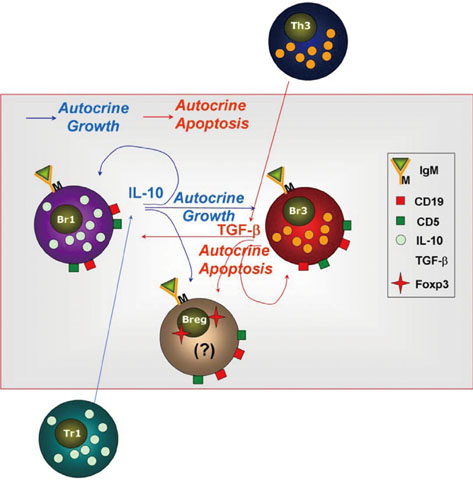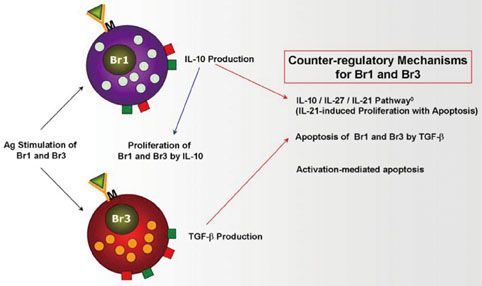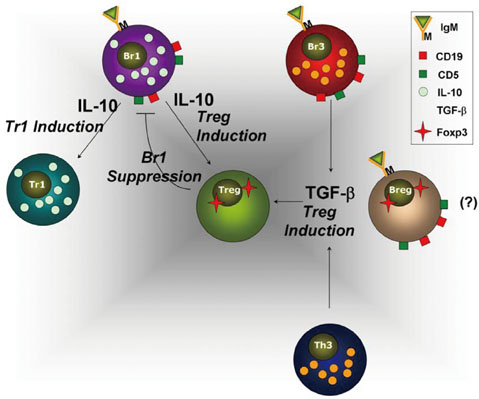Allergy Asthma Immunol Res.
2011 Jul;3(3):168-177. 10.4168/aair.2011.3.3.168.
Regulatory B Cells and Allergic Diseases
- Affiliations
-
- 1Division of Allergy and Clinical Immunology, Department of Paediatrics, Chungnam National University Hospital, Daejeon, Korea. immlee@cnu.ac.kr
- 2Department of Paediatrics, College of Medicine, Chungnam National University, Daejeon, Korea.
- KMID: 1803322
- DOI: http://doi.org/10.4168/aair.2011.3.3.168
Abstract
- B cells are generally considered to positively regulate immune responses by producing antigen-specific antibodies. B cells are classified into classical CD5- conventional B cells and CD5+ B1 cells. The latter produce multi-specific autoantibodies and are thought to be involved in autoimmune diseases. However, evidence supporting a B cell negative regulatory function has accumulated over the past 30 years. Multiple reports have suggested that absence, or loss, of regulatory B cells exacerbates symptoms of both allergic (including contact hypersensitivity and anaphylaxis) and autoimmune (such as experimental autoimmune encephalomyelitis, chronic colitis, and collagen-induced arthritis) diseases, and in lupus-like models of autoimmunity. Regulatory B cells are characterized by production of the negative regulatory cytokines, IL-10 and TGF-beta. IL-10-producing B cells were the first regulatory B cells to be recognized and were termed 'B10' cells. IL-10-producing regulatory B cells are of the CD19(+)CD5(+)IgM(hi)IgD(lo)CD1d(hi) type. Recently, a TGF-beta-producing regulatory B cell subset, Br3, has been shown to be related to immune tolerance in food allergies. Moreover, forkhead box P3 (Foxp3)-expressing B cells have also been identified in humans and may act as regulatory B cells (Bregs). The functional image of regulatory B cells is similar to that of regulatory T cells. Because of the proliferative and apoptotic responses of Br1 and Br3 cells in immune tolerance in non-IgE-mediated food allergy, reciprocal roles and counter-regulatory mechanisms of Br1 and Br3 responses are also suspected. Additionally, different roles for regulatory B and T cells at different time points during initiation and progression of autoimmune disease are described.
Keyword
MeSH Terms
-
Antibodies
Asthma
Autoantibodies
Autoimmune Diseases
Autoimmunity
B-Lymphocytes
B-Lymphocytes, Regulatory
Colitis
Cytokines
Dermatitis, Atopic
Dermatitis, Contact
Encephalomyelitis, Autoimmune, Experimental
Food Hypersensitivity
Humans
Hypersensitivity
Immune Tolerance
Interleukin-10
T-Lymphocytes
T-Lymphocytes, Regulatory
Transforming Growth Factor beta
Antibodies
Autoantibodies
Cytokines
Interleukin-10
Transforming Growth Factor beta
Figure
Cited by 2 articles
-
Regulatory B Cells Are Inversely Associated with Disease Activity in Rheumatoid Arthritis
Jinhyun Kim, Hyun Ji Lee, In Seol Yoo, Seong Wook Kang, Jae Ho Lee
Yonsei Med J. 2014;55(5):1354-1358. doi: 10.3349/ymj.2014.55.5.1354.Role of Interleukin-10-Expressing B Cells on the Pathophysiology of Chronic Sinusitis
Hee Sung Park, Soo Kyoung Park, Sun Hee Yeon, Jun Xu, Ki Sang Rha, Yong Min Kim
Korean J Otorhinolaryngol-Head Neck Surg. 2018;61(8):412-420. doi: 10.3342/kjorl-hns.2017.01067.
Reference
-
1. LeBien TW, Tedder TF. B lymphocytes: how they develop and function. Blood. 2008. 112:1570–1580.2. DiLillo DJ, Hamaguchi Y, Ueda Y, Yang K, Uchida J, Haas KM, Kelsoe G, Tedder TF. Maintenance of long-lived plasma cells and serological memory despite mature and memory B cell depletion during CD20 immunotherapy in mice. J Immunol. 2008. 180:361–371.3. Liu Y, Wu Y, Ramarathinam L, Guo Y, Huszar D, Trounstine M, Zhao M. Gene-targeted B-deficient mice reveal a critical role for B cells in the CD4 T cell response. Int Immunol. 1995. 7:1353–1362.4. O'Neill SK, Cao Y, Hamel KM, Doodes PD, Hutas G, Finnegan A. Expression of CD80/86 on B cells is essential for autoreactive T cell activation and the development of arthritis. J Immunol. 2007. 179:5109–5116.5. Linton PJ, Bautista B, Biederman E, Bradley ES, Harbertson J, Kondrack RM, Padrick RC, Bradley LM. Costimulation via OX40L expressed by B cells is sufficient to determine the extent of primary CD4 cell expansion and Th2 cytokine secretion in vivo. J Exp Med. 2003. 197:875–883.6. Fillatreau S, Gray D, Anderton SM. Not always the bad guys: B cells as regulators of autoimmune pathology. Nat Rev Immunol. 2008. 8:391–397.7. Rieger A, Bar-Or A. B-cell-derived interleukin-10 in autoimmune disease: regulating the regulators. Nat Rev Immunol. 2008. 8:486–487.8. Mauri C, Ehrenstein MR. The 'short' history of regulatory B cells. Trends Immunol. 2008. 29:34–40.9. DiLillo DJ, Matsushita T, Tedder TF. B10 cells and regulatory B cells balance immune responses during inflammation, autoimmunity, and cancer. Ann N Y Acad Sci. 2010. 1183:38–57.10. Lund FE, Randall TD. Effector and regulatory B cells: modulators of CD4+ T cell immunity. Nat Rev Immunol. 2010. 10:236–247.11. Mizoguchi A, Mizoguchi E, Smith RN, Preffer FI, Bhan AK. Suppressive role of B cells in chronic colitis of T cell receptor alpha mutant mice. J Exp Med. 1997. 186:1749–1756.12. Fillatreau S, Sweenie CH, McGeachy MJ, Gray D, Anderton SM. B cells regulate autoimmunity by provision of IL-10. Nat Immunol. 2002. 3:944–950.13. Mizoguchi A, Mizoguchi E, Takedatsu H, Blumberg RS, Bhan AK. Chronic intestinal inflammatory condition generates IL-10-producing regulatory B cell subset characterized by CD1d upregulation. Immunity. 2002. 16:219–230.14. Mauri C, Gray D, Mushtaq N, Londei M. Prevention of arthritis by interleukin 10-producing B cells. J Exp Med. 2003. 197:489–501.15. Evans JG, Chavez-Rueda KA, Eddaoudi A, Meyer-Bahlburg A, Rawlings DJ, Ehrenstein MR, Mauri C. Novel suppressive function of transitional 2 B cells in experimental arthritis. J Immunol. 2007. 178:7868–7878.16. Yanaba K, Bouaziz JD, Haas KM, Poe JC, Fujimoto M, Tedder TF. A regulatory B cell subset with a unique CD1dhiCD5+ phenotype controls T cell-dependent inflammatory responses. Immunity. 2008. 28:639–650.17. Matsushita T, Yanaba K, Bouaziz JD, Fujimoto M, Tedder TF. Regulatory B cells inhibit EAE initiation in mice while other B cells promote disease progression. J Clin Invest. 2008. 118:3420–3430.18. Haas KM, Watanabe R, Matsushita T, Nakashima H, Ishiura N, Okochi H, Fujimoto M, Tedder TF. Protective and pathogenic roles for B cells during systemic autoimmunity in NZB/W F1 mice. J Immunol. 2010. 184:4789–4800.19. Watanabe R, Ishiura N, Nakashima H, Kuwano Y, Okochi H, Tamaki K, Sato S, Tedder TF, Fujimoto M. Regulatory B cells (B10 cells) have a suppressive role in murine lupus: CD19 and B10 cell deficiency exacerbates systemic autoimmunity. J Immunol. 2010. 184:4801–4809.20. Amu S, Saunders SP, Kronenberg M, Mangan NE, Atzberger A, Fallon PG. Regulatory B cells prevent and reverse allergic airway inflammation via FoxP3-positive T regulatory cells in a murine model. J Allergy Clin Immunol. 2010. 125:1114–1124.21. Hardy RR. Isolation of Ly-1+/CD5+ B cells by cell sorting. Curr Protoc Immunol. 2003. Chapter 3:Unit 3 5B.22. Hayakawa K, Hardy RR, Parks DR, Herzenberg LA. The "Ly-1 B" cell subpopulation in normal immunodefective, and autoimmune mice. J Exp Med. 1983. 157:202–218.23. Gadol N, Ault KA. Phenotypic and functional characterization of human Leu1 (CD5) B cells. Immunol Rev. 1986. 93:23–34.24. Schroeder HW Jr, Dighiero G. The pathogenesis of chronic lymphocytic leukemia: analysis of the antibody repertoire. Immunol Today. 1994. 15:288–294.25. Youinou P, Mackenzie L, Broker BM, Isenberg DI, Drogou-Lelong A, Gentric A, Lydyard PM. The importance of CD5-positive B cells in nonorgan-specific autoimmune diseases. Scand J Rheumatol Suppl. 1988. 76:243–249.26. Kasaian MT, Casali P. Autoimmunity-prone B-1 (CD5 B) cells, natural antibodies and self recognition. Autoimmunity. 1993. 15:315–329.27. Shlomchik MJ, Craft JE, Mamula MJ. From T to B and back again: positive feedback in systemic autoimmune disease. Nat Rev Immunol. 2001. 1:147–153.28. Mizoguchi A, Bhan AK. A case for regulatory B cells. J Immunol. 2006. 176:705–710.29. Bouaziz JD, Yanaba K, Tedder TF. Regulatory B cells as inhibitors of immune responses and inflammation. Immunol Rev. 2008. 224:201–214.30. Yanaba K, Bouaziz JD, Matsushita T, Tsubata T, Tedder TF. The development and function of regulatory B cells expressing IL-10 (B10 cells) requires antigen receptor diversity and TLR signals. J Immunol. 2009. 182:7459–7472.31. Roncarolo MG, Gregori S, Battaglia M, Bacchetta R, Fleischhauer K, Levings MK. Interleukin-10-secreting type 1 regulatory T cells in rodents and humans. Immunol Rev. 2006. 212:28–50.32. Berg DJ, Davidson N, Kühn R, Müller W, Menon S, Holland G, Thompson-Snipes L, Leach MW, Rennick D. Enterocolitis and colon cancer in interleukin-10-deficient mice are associated with aberrant cytokine production and CD4+ TH1-like responses. J Clin Invest. 1996. 98:1010–1020.33. Amano M, Baumgarth N, Dick MD, Brossay L, Kronenberg M, Herzenberg LA, Strober S. CD1 expression defines subsets of follicular and marginal zone B cells in the spleen: β2-microglobulin-dependent and independent forms. J Immunol. 1998. 161:1710–1717.34. Lee JH, Noh J, Noh G, Choi WS, Cho S, Lee SS. IL-10 is predominantly produced by the CD19(low)CD5(+) regulatory B cell subpopulation: characterisation of CD19(high) and CD19(low) subpopulations of CD5(+) B cells. Yonsei Med J. 2011. 09. Forthcoming.35. Vitale G, Mion F, Pucillo C. Regulatory B cells: evidence, developmental origin and population diversity. Mol Immunol. 2010. 48:1–8.36. Lotz M, Ranheim E, Kipps TJ. Transforming growth factor b as endogenous growth inhibitor of chronic lymphocytic leukemia B cells. J Exp Med. 1994. 179:999–1004.37. Douglas RS, Woo EY, Capocasale RJ, Tarshis AD, Nowell PC, Moore JS. Altered response to and production of TGF-β by B cells from autoimmune NZB mice. Cell Immunol. 1997. 179:126–137.38. Lee JH, Noh J, Noh G, Choi WS, Cho S, Lee SS. Allergen-specific transforming growth factor-β-producing CD19(+)CD5(+) regulatory B-cell (Br3) responses in human late eczematous allergic reactions to cow's milk. J Interferon Cytokine Res. 2011. 31:441–449.39. Noh J, Choi WS, Noh G, Lee JH. Presence of Foxp3-expressing CD19(+)CD5(+) B cells in human peripheral blood mononuclear cells: human CD19(+)CD5(+)Foxp3(+) regulatory B cell (Breg). Immune Netw. 2010. 10:247–249.40. Kitabayashi A, Hirokawa M, Miura AB. The role of interleukin-10 (IL-10) in chronic B-lymphocytic leukemia: IL-10 prevents leukemic cells from apoptotic cell death. Int J Hematol. 1995. 62:99–106.41. Noh J, Lee JH, Noh G, Bang SY, Kim HS, Choi WS, Cho S, Lee SS. Characterisation of allergen-specific responses of IL-10-producing regulatory B cells (Br1) in cow milk allergy. Cell Immunol. 2010. 264:143–149.42. Koide N, Sugiyama T, Mu MM, Mori I, Yoshida T, Hamano T, Yokochi T. Gamma interferon-induced nitric oxide production in mouse CD5+ B1-like cell line and its association with apoptotic cell death. Microbiol Immunol. 2003. 47:669–679.43. Panayiotidis P, Ganeshaguru K, Jabbar SA, Hoffbrand AV. Interleukin-4 inhibits apoptotic cell death and loss of the bcl-2 protein in B-chronic lymphocytic leukaemia cells in vitro. Br J Haematol. 1993. 85:439–445.44. Reittie JE, Yong KL, Panayiotidis P, Hoffbrand AV. Interleukin-6 inhibits apoptosis and tumour necrosis factor induced proliferation of B-chronic lymphocytic leukaemia. Leuk Lymphoma. 1996. 22:83–90.45. Lagneaux L, Delforge A, Bron D, Massy M, Bernier M, Stryckmans P. Heterogenous response of B lymphocytes to transforming growth factor-β in B-cell chronic lymphocytic leukaemia: correlation with the expression of TGF-β receptors. Br J Haematol. 1997. 97:612–620.46. Schuler M, Tretter T, Schneller F, Huber C, Peschel C. Autocrine transforming growth factor-β from chronic lymphocytic leukemia-B cells interferes with proliferative T cell signals. Immunobiology. 1999. 200:128–139.47. Watanabe R, Fujimoto M, Ishiura N, Kuwano Y, Nakashima H, Yazawa N, Okochi H, Sato S, Tedder TF, Tamaki K. CD19 expression in B cells is important for suppression of contact hypersensitivity. Am J Pathol. 2007. 171:560–570.48. Mangan NE, van Rooijen N, McKenzie AN, Fallon PG. Helminth-modified pulmonary immune response protects mice from allergen-induced airway hyperresponsiveness. J Immunol. 2006. 176:138–147.49. Tsuji RF, Szczepanik M, Kawikova I, Paliwal V, Campos RA, Itakura A, Akahira-Azuma M, Baumgarth N, Herzenberg LA, Askenase PW. B cell-dependent T cell responses: IgM antibodies are required to elicit contact sensitivity. J Exp Med. 2002. 196:1277–1290.50. Nakashima H, Hamaguchi Y, Watanabe R, Ishiura N, Kuwano Y, Okochi H, Takahashi Y, Tamaki K, Sato S, Tedder TF, Fujimoto M. CD22 expression mediates the regulatory functions of peritoneal B-1a cells during the remission phase of contact hypersensitivity reactions. J Immunol. 2010. 184:4637–4645.51. Matsumura Y, Byrne SN, Nghiem DX, Miyahara Y, Ullrich SE. A role for inflammatory mediators in the induction of immunoregulatory B cells. J Immunol. 2006. 177:4810–4817.52. Szczepanik M, Akahira-Azuma M, Bryniarski K, Tsuji RF, Kawikova I, Ptak W, Kiener C, Campos RA, Askenase PW. B-1 B cells mediate required early T cell recruitment to elicit protein-induced delayed-type hypersensitivity. J Immunol. 2003. 171:6225–6235.53. Kawikova I, Paliwal V, Szczepanik M, Itakura A, Fukui M, Campos RA, Geba GP, Homer RJ, Iliopoulou BP, Pober JS, Tsuji RF, Askenase PW. Airway hyper-reactivity mediated by B-1 cell immunoglobulin M antibody generating complement C5a at 1 day post-immunization in a murine hapten model of non-atopic asthma. Immunology. 2004. 113:234–245.54. Lundy SK, Berlin AA, Martens TF, Lukacs NW. Deficiency of regulatory B cells increases allergic airway inflammation. Inflamm Res. 2005. 54:514–521.55. Yazdanbakhsh M, Kremsner PG, van Ree R. Allergy, parasites, and the hygiene hypothesis. Science. 2002. 296:490–494.56. Fallon PG, Mangan NE. Suppression of TH2-type allergic reactions by helminth infection. Nat Rev Immunol. 2007. 7:220–230.57. Anthony RM, Rutitzky LI, Urban JF Jr, Stadecker MJ, Gause WC. Protective immune mechanisms in helminth infection. Nat Rev Immunol. 2007. 7:975–987.58. Maizels RM, Balic A, Gomez-Escobar N, Nair M, Taylor MD, Allen JE. Helminth parasites--masters of regulation. Immunol Rev. 2004. 201:89–116.59. Hawrylowicz CM, O'Garra A. Potential role of interleukin-10-secreting regulatory T cells in allergy and asthma. Nat Rev Immunol. 2005. 5:271–283.60. Mangan NE, Fallon RE, Smith P, van Rooijen N, McKenzie AN, Fallon PG. Helminth infection protects mice from anaphylaxis via IL-10-producing B cells. J Immunol. 2004. 173:6346–6356.61. Sampson HA. Role of immediate food hypersensitivity in the pathogenesis of atopic dermatitis. J Allergy Clin Immunol. 1983. 71:473–480.62. Grewe M, Bruijnzeel-Koomen CA, Schopf E, Thepen T, Langeveld-Wildschut AG, Ruzicka T, Krutmann J. A role for Th1 and Th2 cells in the immunopathogenesis of atopic dermatitis. Immunol Today. 1998. 19:359–361.63. Ramesh S. Food allergy overview in children. Clin Rev Allergy Immunol. 2008. 34:217–230.64. Kemp AS. Egg allergy. Pediatr Allergy Immunol. 2007. 18:696–702.65. Sabra A, Bellanti JA, Rais JM, Castro HJ, de Inocencio JM, Sabra S. IgE and non-IgE food allergy. Ann Allergy Asthma Immunol. 2003. 90:71–76.66. Antin JH, Emerson SG, Martin P, Gadol N, Ault KA. Leu-1+ (CD5+) B cells. A major lymphoid subpopulation in human fetal spleen: phenotypic and functional studies. J Immunol. 1986. 136:505–510.67. Villaseñor-Bustamante S, Alvarado-De La Barrera C, Richaud-Patin Y, Martinez-Ayala H, Llorente L. Possible role of interleukin-10 in autoantibody production and in the fate of human cord blood CD5+ B lymphocytes. Scand J Immunol. 1999. 49:629–632.68. Burdin N, Rousset F, Banchereau J. B-cell-derived IL-10: production and function. Methods. 1997. 11:98–111.69. Blair PA, Noreña LY, Flores-Borja F, Rawlings DJ, Isenberg DA, Ehrenstein MR, Mauri C. CD19+CD24hiCD38hi B cells exhibit regulatory capacity in healthy individuals but are functionally impaired in systemic lupus erythematosus patients. Immunity. 2010. 32:129–140.70. Tsitoura DC, Yeung VP, DeKruyff RH, Umetsu DT. Critical role of B cells in the development of T cell tolerance to aeroallergens. Int Immunol. 2002. 14:659–667.71. Lohr J, Knoechel B, Abbas AK. Regulatory T cells in the periphery. Immunol Rev. 2006. 212:149–162.72. Stohl W, Elliott JE. Differential human T cell-dependent B cell differentiation induced by staphylococcal superantigens (SAg). Regulatory role for SAg-dependent B cell cytolysis. J Immunol. 1995. 155:1838–1850.73. Fujio K, Okamura T, Yamamoto K. The family of IL-10-secreting CD4(+) T cells. Adv Immunol. 2010. 105:99–130.74. Zhang L, Yi H, Xia XP, Zhao Y. Transforming growth factor-β: an important role in CD4(+)CD25(+) regulatory T cells and immune tolerance. Autoimmunity. 2006. 39:269–276.75. Matsushita T, Horikawa M, Iwata Y, Tedder TF. Regulatory B cells (B10 cells) and regulatory T cells have independent roles in controlling experimental autoimmune encephalomyelitis initiation and late-phase immunopathogenesis. J Immunol. 2010. 185:2240–2252.76. Groux H, O'Garra A, Bigler M, Rouleau M, Antonenko S, de Vries JE, Roncarolo MG. A CD4+ T-cell subset inhibits antigen-specific T-cell responses and prevents colitis. Nature. 1997. 389:737–742.







